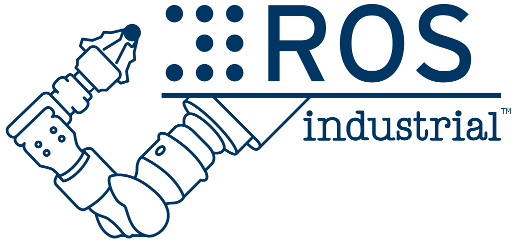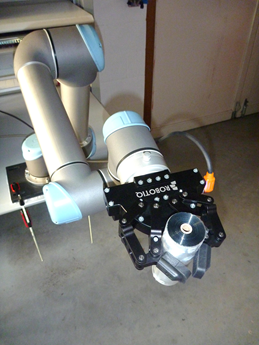What is ROS and ROS-Industrial for Robots?
.jpg?width=311&height=146&name=ros_industrial_logo(tm).jpg) ROS is an open-source collaborative system designed to help share the code needed to manipulate your robot. Originally ROS was not intended for industrial use, but rather started in 2007 as a project at the Stanford Artificial Intelligence Laboratory in conjunction with more than twenty institutions that collaborated on the development model. It was not until 2011 that Southwest Research Institute (SwRI), Willow Garage (now disbanded), and Yaskawa-Motoman Robotics expanded on ROS with ROS-Industrial to bring advanced robotics software to the industrial automation domain. The first industrial manipulator to run an industrial robot client was a Motoman SIA 20D with DX100 controller, which would become the architecture for the driver layer in the ROS-I socket interface for manipulation.
ROS is an open-source collaborative system designed to help share the code needed to manipulate your robot. Originally ROS was not intended for industrial use, but rather started in 2007 as a project at the Stanford Artificial Intelligence Laboratory in conjunction with more than twenty institutions that collaborated on the development model. It was not until 2011 that Southwest Research Institute (SwRI), Willow Garage (now disbanded), and Yaskawa-Motoman Robotics expanded on ROS with ROS-Industrial to bring advanced robotics software to the industrial automation domain. The first industrial manipulator to run an industrial robot client was a Motoman SIA 20D with DX100 controller, which would become the architecture for the driver layer in the ROS-I socket interface for manipulation.
As of February 2013, ROS stewardship transitioned to the Open Source Robotics Foundation, while ROS-I is maintained by SwRI Robotics and Automation in conjunction with the ROS-Industrial Consortium.
If you want a more detailed description of how and why the expansion and separation of ROS to ROS-I happened you can listen to a talk by one of the founders Shaun Edwards. He explains the importance of the industrial platform and talks about the gap between university research and industrial applications. The fact remains that while money is made in industrial applications, development just isn’t happening there, as they have other concerns, such as maintaining their present systems. Yet, it seems that closed industrial systems don't allow you to leverage applications the way an open-source system does. Industrial systems are project oriented and thus not as broad as ROS-Industrial, so ROS-I can advance features and functionality, while minimizing barriers to interoperability.
Advantages of ROS-Industrial
Some of the advantages of using a community based open-source system include:
-
Makes it easy to get the innovations from the university labs out into the market,

-
User testing will find and patch bugs quickly,
-
Users can always add or change the source code to suit their own purposes,
-
Open-source, BSD licensed code makes it easy for users to incorporate ROS functionality into their products.
-
Broad based solutions, not specific niche development,
-
Interchangeability of hardware components through standardized interfaces,
-
Manufacturer-independent open-source drivers,
-
Intelligent software components for flexible production cells,
-
Provides standardized access to applications which increases dramatically the number of applications available,
-
These features allow for an effective interface between workcells.
Why we need open source?
You could say that we have been moving forward in robotics for the past 50 years, maybe it is not a blitzkrieg, but it's steadily. It's steady because the problems have been attacked one at a time, usually individually for each problem, a solution. The problems are not insurmountable, but there are a lot of pieces to each problem and each solution. This is the perfect environment for an open-source community that shares technologies and works towards common goals. User-generated content creates value for the whole community. One goal of ROS-Industrial is to provide standardization for industrial robotic platforms through a ROS interface standard for industrial robot controllers. This would allow developers to leverage higher level ROS software. So, anybody creating a ROS-Industrial driver would adhere to this standard. It would allow plug-and-play components to to solve more problems, more easily.
One of the historic problems with technology is that closed proprietary systems slow down the development of systems which cannot interact easily. With a common non-proprietary structure many developers can solve innumerable problems simultaneously. This moves robot development along at a pace which is equal to the demand for robot applications.
The ROS-Industrial Consortium
The ROS-Industrial Consortium web page has information for partners, who would like to be involved in the continued development of ROS-Industrial. Your company might have specific industrial applications or practices that are difficult to integrate with ROS-Industrial for technical reasons or for business model reasons. This membership required organization provides cost-sharing applied R&D for advanced factory automation. If you think this is your specific situation start here.
RIC EU
Recently, Yaskawa teamed up with Fraunhofer IPA to create the ROS-Industrial Consortium Europe. They are working on expanding ROS-Industrial into Europe, as well as expanding the standard ROS-I interface for dual arm robots.
And if we look at the demand for robots and robotic applications today, there is no reason to fear losing our proprietary edge, because the demand generated by compatible systems simply means there are more places for more robots!







Leave a comment